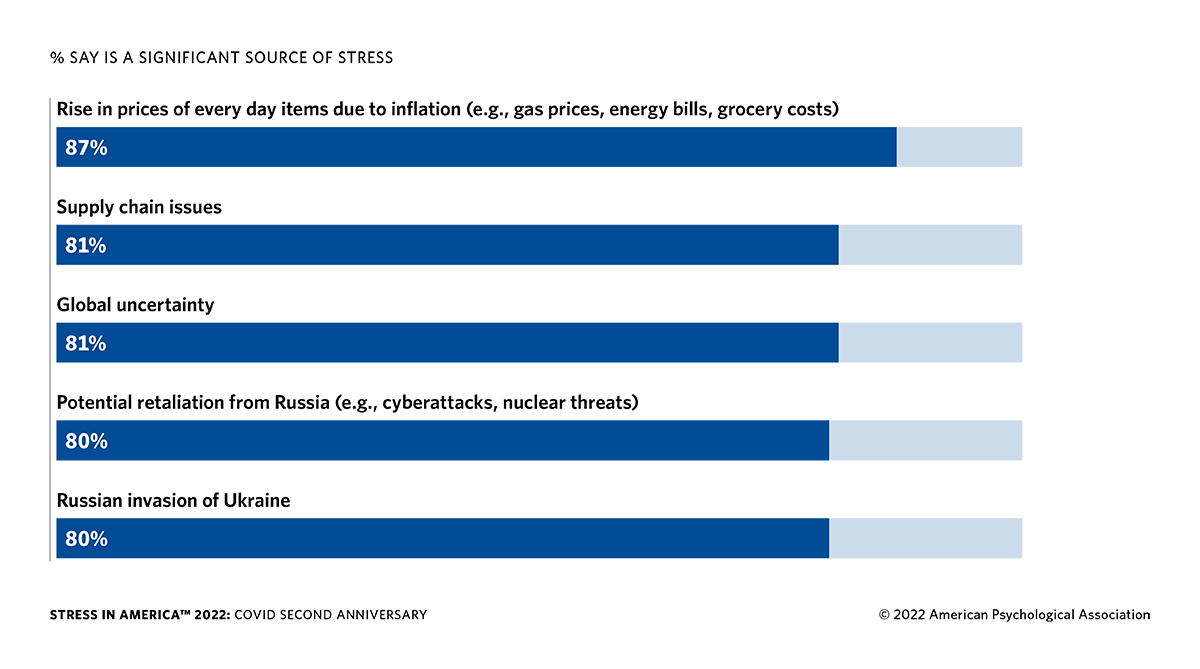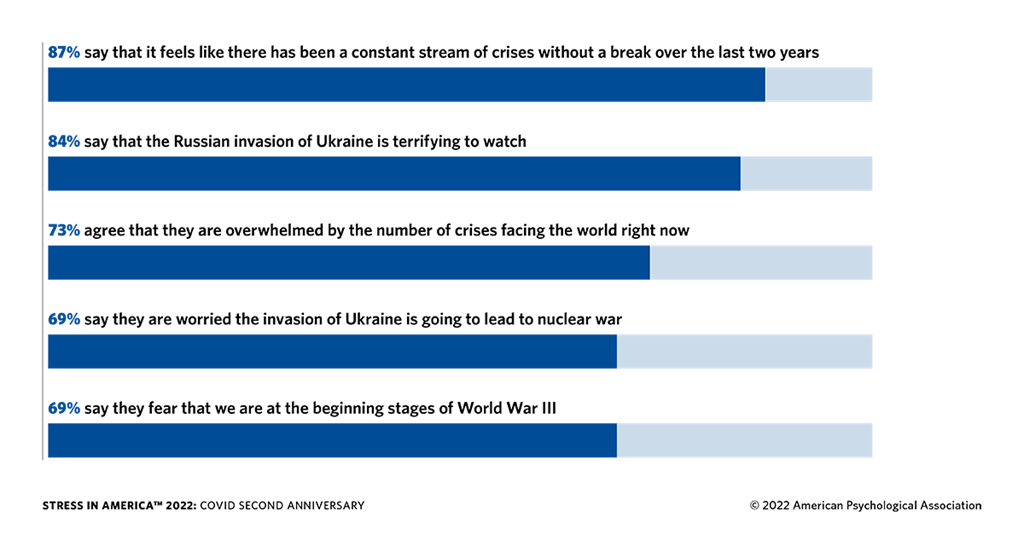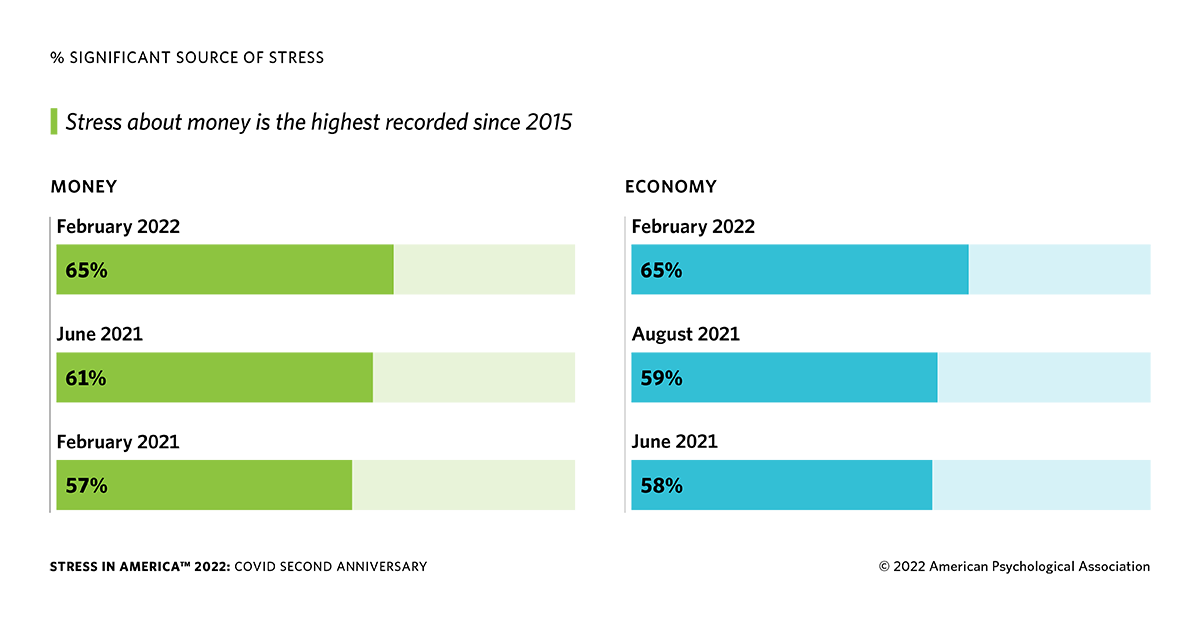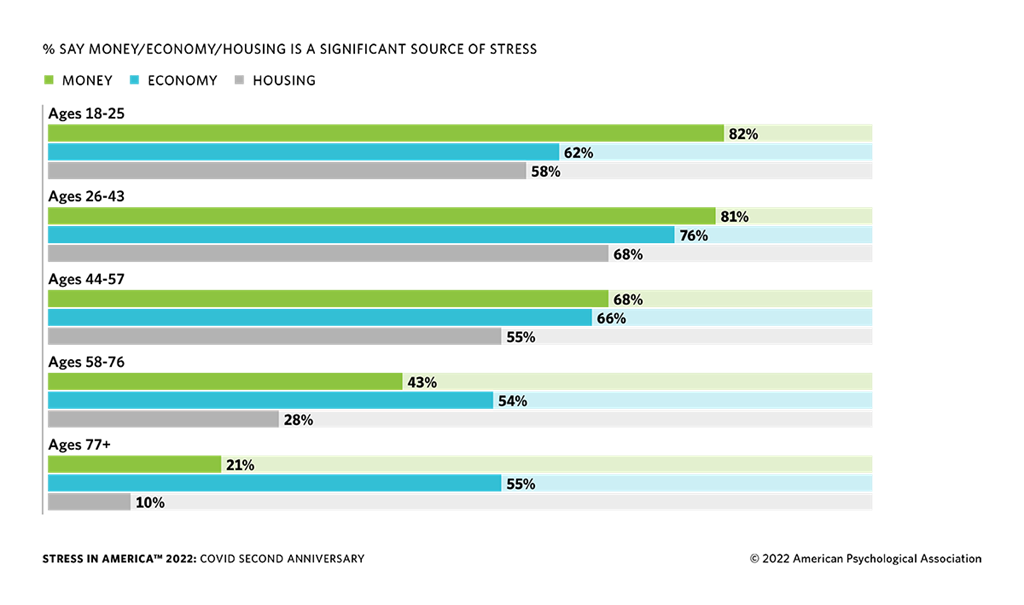
Two years after the World Health Organization declared COVID-19 a global pandemic, inflation, money issues and the war in Ukraine have pushed U.S. stress to alarming levels, according to polls conducted for the American Psychological Association.
A late-breaking poll, fielded March 1–3 by The Harris Poll on behalf of APA, revealed striking findings, with more adults rating inflation and issues related to the invasion of Ukraine as stressors than any other issue asked about in the 15-year history of the Stress in AmericaTM poll. This comes on top of money stress at the highest recorded level since 2015, according to a broader Stress in America poll fielded last month.
Top sources of stress were the rise in prices of everyday items due to inflation (e.g., gas prices, energy bills, grocery costs, etc.) (cited by 87%), followed by supply chain issues (81%), global uncertainty (81%), Russia’s invasion of Ukraine (80%) and potential retaliation from Russia (e.g., in the form of cyberattacks or nuclear threats) (80%).

These stressors are coming at a time when the nation is still struggling to deal with the prolonged pandemic and its effects on our daily lives, with close to two-thirds of adults (63%) saying their life has been forever changed by the COVID-19 pandemic. While a majority (51%) reported this change as neither positive nor negative — simply different — the long-lasting implications of the pandemic are clear. The survey also revealed continued hardships for vulnerable populations, concerns for children’s development among parents and entrenched, unhealthy coping habits.

“The number of people who say they’re significantly stressed about these most recent events is stunning relative to what we’ve seen since we began the survey in 2007,” said Arthur C. Evans Jr., PhD, APA’s chief executive officer. “Americans have been doing their best to persevere over these past two tumultuous years, but these data suggest that we’re now reaching unprecedented levels of stress that will challenge our ability to cope.”
A year ago, APA’s first pandemic anniversary survey found COVID-19-related stress was associated with unhealthy weight changes and increased drinking. The most recent survey confirmed that these unhealthy behaviors have persisted, suggesting that coping mechanisms have become entrenched — and that mental and physical health may be on a continuing decline for many as a result. Close to half of adults (47%) said they have been less active than they wanted to be since the pandemic started, and close to three in five (58%) reported experiencing undesired weight changes.

Among those who gained more weight than they wanted, the average amount of weight gained was 26 pounds, with a median of 15 pounds. On the other hand, the average amount of weight lost among those who lost more than they wanted to was 27 pounds, with a median of 15 pounds. More than one in five Americans (23%) said they have been drinking more alcohol during the COVID-19 pandemic, with those who have been drinking more consuming an average of 10 drinks per week (and a median of six drinks per week) compared with an average of two drinks (and a median of one drink) per week among those who did not report drinking more.

Adults also reported separation and conflict as causes for straining and/or ending of relationships. Half of adults (51%, particularly essential workers at 61%) said they have loved ones they have not been able to see in person in the past two years as a result of the COVID-19 pandemic. Strikingly, more than half of all U.S. adults (58%) reported experiencing a relationship strain or end as a result of conflicts related to the COVID-19 pandemic, including canceling events or gatherings due to COVID-19 concerns (29%); difference of opinion over some aspect of vaccines (25%); different views of the pandemic overall (25%); and difference of opinion over mask-wearing (24%).
Strained social relationships and reduced social support during the pandemic make coping with stress more difficult. In fact, more than half of respondents (56%) said that they could have used more emotional support than they received since the pandemic started. “We know from decades of research that healthy and supportive relationships are key to promoting resilience and building people’s mental wellness,” said Evans. “Particularly during periods of prolonged stress, it’s important that we facilitate opportunities for social connection and support.”
The majority of parents reported concerns regarding child(ren)’s development, including social life or development (73%), academic development (71%) and emotional health or development (71%). More than two-thirds of parents reported concern about the pandemic’s impact on their child’s cognitive development (68%) and their physical health/development (68%).
“Living through historic threats like these often has a lasting, traumatic impact on generations,” said Evans. “As a society, it’s important that we ensure access to evidence-based treatments and that we provide help to everyone who needs it. This means not only connecting those in distress with effective and efficient clinical care, but also mitigating risk for those more likely to experience challenges and engaging in prevention for those who are relatively healthy.”


